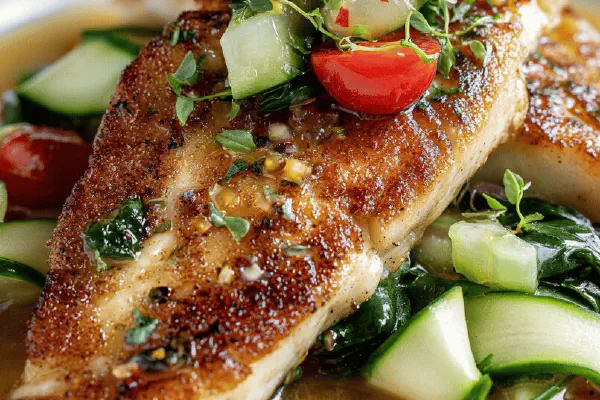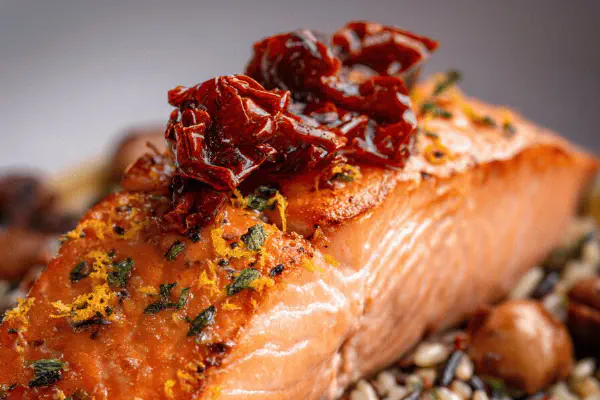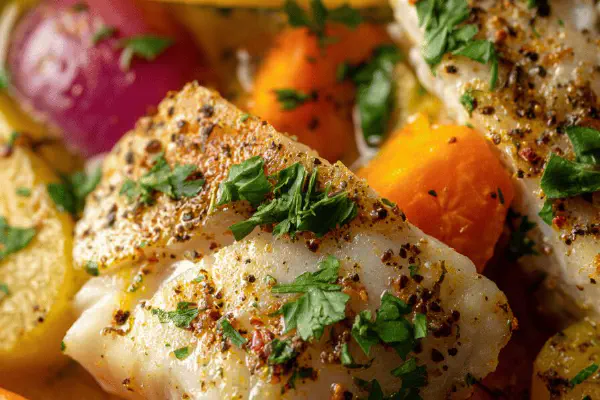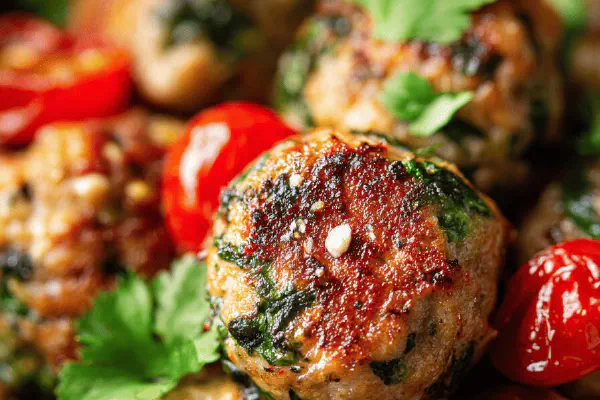White Fish Ginger Chard
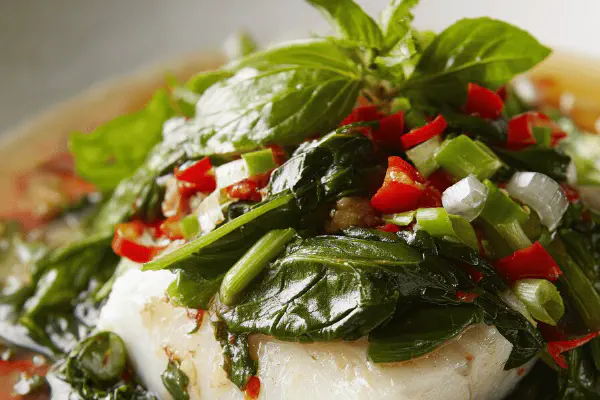
E
By Emma
Certified Culinary Professional
•
Recipe tested & approved
Tender white fish cooked in a fragrant broth of ginger, garlic, and soy-sauce infused chard leaves. The stems soften first to build texture. Broth seasoned with lime juice, fish sauce, and a touch of chili paste. Olive oil finishes the dish, adding subtle richness. Takes roughly 40 minutes from start to finish. Serves four. Ingredients adjusted for balance and spice. A bright, light main course often found in East Asian-inspired meals. Savory, aromatic, with fresh green vegetable notes from Swiss chard. Fish gently poached to maintain delicate texture. A recipe with minimal dairy, nut-free, egg-free, ideal for various diets.
Prep:
25 min
Cook:
40 min
Total:
65 min
Servings:
4 servings
#fish
#healthy
#dinner
#Asian flavors
Fish simmering in broth. Bits of chard stem softened first. Garlic and ginger punch in early. Heat rising, bubbling, steam escaping. Lime juice spreads zingy notes, balancing sauces – oyster and tamari soy. Chili flakes slip quietly into mix, teasing heat. Leaves of chard fold gently, wilt fast. Then fish laid atop, barely salted to avoid over-salting. Cooking just enough. Broth spooned over, keeps moist, tender flakes. Olive oil drizzled when plated. Fresh, light. Cui’s essential Asian flavors minus dairy, nuts, eggs. Simple swap of sauces alters depth. Texture mix from stem crunch and leafy softness. A meal under 45 minutes in busy kitchens.
Ingredients
- 1 bunch Swiss chard stems and leaves, about 300 grams (10 oz), stems chopped, leaves roughly chopped
- 1 small shallot, finely sliced
- 2 cloves garlic, minced
- 25 ml (1 2/3 tbsp) freshly grated ginger
- 40 ml (3 tbsp) avocado oil
- 450 ml (1 3/4 cups) vegetable broth
- 12 ml (2 1/2 tsp) tamari soy sauce
- 10 ml (2 tsp) lime juice
- 12 ml (2 1/2 tsp) oyster sauce
- Sambal oelek or thinly sliced fresh chili, adjust to taste
- 600 g (1 1/3 lb) cod fillets or similar white fish, cut into portions
- Salt and cracked black pepper
About the ingredients
Reduce chard quantity slightly to 300g for better broth flavor concentration. Replace olive oil with avocado oil to boost smoke point and add subtle nutty flavor. Oyster sauce swapped in for fish sauce for rounded umami with less saltiness. Tamari soy sauce exchanged for traditional soy adding smoother saltiness without wheat. Ginger amount slightly reduced but still prominent. Broth now vegetable-based, accommodating plant-based eaters while keeping depth. Lime juice amount fine-tuned for equilibrium with other acidic elements. Garlic, shallot, and chili remain anchors but chili made optional to suit tolerance. These changes give the dish a fresher appearance and nuanced flavor profile. The fish portion trimmed to suit smaller appetite or side servings. Simple tweaks, noticeable shift in taste, texture, and cooking dynamics.
Method
- Separate chard leaves from stems. Chop stems finely, leaves coarsely enough to make about 1.5 liters (6 cups). Set aside.
- Heat oil in a wok or large deep skillet over medium. Add chard stems, shallot, garlic, and ginger. Sauté gently until stems start to soften, 6 to 7 minutes.
- Pour in broth, add tamari, oyster sauce, lime juice, and chili paste. Bring to a gentle boil. Cover and let simmer for 7 minutes.
- Add chard leaves. Stir briefly, cover again, and cook until just wilted, about 1 minute.
- Lightly salt fish; place pieces on top of chard without overlapping. Cover and cook 4 to 5 minutes, periodically spooning broth over fish to keep moist.
- Remove from heat. Plate by dividing chard stems and leaves among bowls, layering fish on top. Ladle broth around fish. Drizzle with extra oil if desired. Season with fresh pepper.
Cooking tips
Start by separating chard stems and leaves. Stems chopped finer so they soften evenly; leaves roughly for volume and quicker cooking. Use medium heat for initial sauté to prevent garlic burning, about 6 or 7 minutes until stems are a bit tender. Adding broth and seasoning liquids next lets flavors meld and reduces rawness of aromatics. Covering the pan keeps steam in and cooks stems evenly. After simmering, leaves added last because they wilt nearly instantly, just a minute. Fish placed on top to avoid overcooking in active liquid and for flavor layering. Salt fish lightly because sauces bring saltiness. Cooking last 4 to 5 minutes depends on thickness—fish flakes when done. Spoon broth regularly to keep moisture consistent, prevents drying on surface. Presentation involves layering veggies, fish, then ladling broth. Optional finishing oil adds silkiness and aroma. Time adjustments keep components tender, not mushy or underdone.
Chef's notes
- 💡 Separate chard stems and leaves. Stems need more time, chop finely. Leaves roughly chopped. Makes even cooking. Keeps volume high. No mush. Don't rush the sauté. Medium heat only here. About six to seven minutes.
- 💡 When adding broth, time is crucial. Pour carefully. Let the mix boil gently. Covering keeps steam in. Flats flavors come out well. Chillies optional, adjust them. Sambal brings a kick. Taste as you go.
- 💡 Fish shouldn't sink. Place on top of chard. This avoids overcooking. Four to five minutes is key timing. Fish flakes nicely when done. Salt lightly. It's got umami already. Don't drown it.
- 💡 Final presentation matters. Layer veggies well, then fish on top. Ladle broth around. Drizzle oil if desired. Optional touch at the end. Keeps moisture locked. Adds aroma.
- 💡 If unsure about cooking times, check thickness. Thicker fillets require more time. Don't be shy to spoon broth. Regular moisture keeps it tender. Ensure uniform cooking. Watch the fish closely.
Common questions
What type of fish works best?
Any white fish is good. Cod works well. Check for freshness. Firm flesh is key. Flaky fish holds broth nicely, don't choose oily types.
Can I use frozen fish?
Yes but thaw well. Important to even cooking. Check time adjustment. Slightly longer if thick. Avoid skipping thawing. It matters.
How to store leftovers?
Keep in airtight container. Refrigerate promptly. Consume within two days. Reheat gently on low. Don't overheat, fish dries out. Broth thins.
What about spice levels?
Adjust heat to your taste. Start with less. Add more chili if needed. Balance is key. Not overpowering. Keep it enjoyable.
